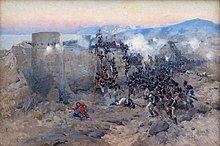Storming of Lankaran
| Storming of Lankaran | |||||||
|---|---|---|---|---|---|---|---|
| Part of the Russo-Persian War (1804–13) | |||||||
 Storming of Lankaran, January 13th, 1813. Painted by Franz Roubaud. |
|||||||
|
|||||||
| Belligerents | |||||||
|
|
|
||||||
| Commanders and leaders | |||||||
|
|
|
||||||
| Strength | |||||||
|
|
||||||
| Casualties and losses | |||||||
|
|
||||||
The Storming of Lankaran (Persian: یورش به لنکران — Yuresh be Lankaran; Russian: Штурм Ленкорани) took place on 1 January 1813 as part of the Russo-Persian War (1804-1813). It was noted for its bitterness and cruelty.
After a siege of five days, which included the shelling of the place, the Russians managed to storm the citadel, despite a Persian numerical superiority. Though suffering heavy losses in the siege during which most of the officers and non-commissioned officers were killed, the Russians, by taking the Persian fortress, had thereby taken Lankaran.
After having taken the fortress, all survivors were murdered by the Russians and none were taken captive. General Kotlyarevsky himself became heavily injured during the siege after which he couldn't participate anymore, while Sadiq Khan, the Persian commander, was killed during the storming of the fortress. Of the besieging Russian 17th Jaeger regiment consisting of 296 people only 74 of them survived the battle.
In the course of the ongoing Russo-Persian War (1804-1813), the British managed to build a strong fortress in Lankaran.
According to eyewitnesses "she made a strong impression by high stone walls and rows of sharp teeth". Furthermore, the citadel was surrounded by deep trenches. It had a shape of an irregular quadrilateral (80 fathoms width), with the left bank of the river Lankaranki, which is situated not far from the Caspian Sea, in the marshes nearby the citadel. Most of the southwest side stretched up for up to 130 meters long. The length of the northeast side, built in the shape of an irregular polygon, stretched up to 80 meters. The south-east side (along the river and towards the Caspian Sea) and from the northwest (from the front to the villages of Gamushevani were 100 meters long each. Besides that, on each corner were bastions located. The most imposing of them were the ones from the northeastern side. The ditch in front of the citadel was 4 meters deep and 10 meters in width.
...
Wikipedia
